Carl E. Olson's Blog, page 36
August 15, 2015
"The Assumption" by Monsignor Ronald Knox

The Assumption | Mgr. Ronald Knox | From Pastoral and Occasional Sermons | August 15th | Ignatius Insight
A cave Jeremias found there, in which he set down tabernacle and ark and incense-altar, and stopped up the entrance behind him. There were some that followed; no time they lost in coming up to mark the spot, but find it they could not.—2 Machabees 2:5-6.
After this, God's heavenly temple was thrown open, and the ark of the covenant was plain to view, standing in his temple.—Apocalypse 11:19.
The Son of God came to earth to turn our hearts away from earth, Godwards. The 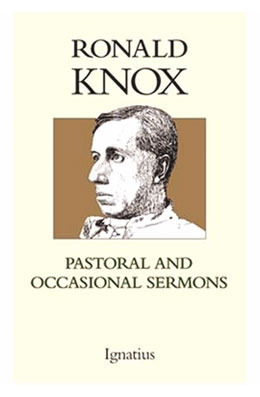 material world in which we live was, by his way of it, something immaterial; it didn't matter. We were not to be always worrying about our clothes being shabby, or wondering where our next meal was to come from; the God who fed the sparrows and clothed the lilies would see to all that. We were not to resent the injuries done to us by our neighbours; the aggressor was welcome to have a slap at the other cheek, and when he took away our greatcoat he was to find that we had left our coat inside it. Life itself, the life we know, was a thing of little value; it was a cheap bargain, if we lost life here to attaIn the life hereafter. There was a supernatural world, interpenetrating, at a higher level, the world of our experience; it has its own laws, the only rule we were to live by, its own prizes, which alone were worth the winning. All that he tried to teach us; and we, intent on our own petty squabbles, our sordid struggle for existence, cold-shouldered him at first, and then silenced his protest with a cross.
material world in which we live was, by his way of it, something immaterial; it didn't matter. We were not to be always worrying about our clothes being shabby, or wondering where our next meal was to come from; the God who fed the sparrows and clothed the lilies would see to all that. We were not to resent the injuries done to us by our neighbours; the aggressor was welcome to have a slap at the other cheek, and when he took away our greatcoat he was to find that we had left our coat inside it. Life itself, the life we know, was a thing of little value; it was a cheap bargain, if we lost life here to attaIn the life hereafter. There was a supernatural world, interpenetrating, at a higher level, the world of our experience; it has its own laws, the only rule we were to live by, its own prizes, which alone were worth the winning. All that he tried to teach us; and we, intent on our own petty squabbles, our sordid struggle for existence, cold-shouldered him at first, and then silenced his protest with a cross.
His answer was to rise from the dead; and then, for forty days in the world's history, that supernatural life which he had preached to us flourished and functioned under the conditions of earth. A privileged few saw, with mortal eyes, the comings and goings of immortality, touched with their hands the impalpable. For forty days; then, as if earth were too frail a vessel to contain the mystery, the tension was suddenly relaxed. He vanished behind a cloud; the door of the supernatural shut behind him, and we were left to the contemplation of this material world, drab and barren as ever.
What was the first thing the apostles saw when they returned from the mount of the Ascension to the upper room? "Together with Mary"—is it only an accident that the Mother of God is mentioned just here, by name, and nowhere else outside the gospels? The Incarnate Word had left us, as silently as he came to us, leaving no trace behind him of his passage through time. No trace? At least, in the person of his blessed Mother, he had bequeathed to us a keepsake, a memory. She was bone of his bone, flesh of his flesh, the new Eve of the new Adam. That body of hers, still part of the material order of things, had housed and suckled God. As long as she lived, there would still be a link, a golden link, between this lower earth and Paradise. As long as she lived; and even if it was God's will that she, Eve's daughter, should undergo the death that was Eve's penalty, the penalty she had never incurred, her mortal remains would still be left with us, an echo from the past, an influence on our lives.
We men, since we are body and soul, do honour even to the lifeless bodies which have housed the dead; Napoleon rests in the Invalides, Lenin at Moscow. The day would come when there would be pilgrimages from all over the world to the shrines of Peter and Paul at Rome, of James at Compostela. Was it not reasonable to hope that somewhere, at Jerusalem, perhaps, or at Ephesus, we should be privileged to venerate the mortal remains of her through whom salvation came to us? Or perhaps at Bethlehem, Bethlehem-Ephrata, this new Ark of God would rest, as the ark rested of old; "And now, at Ephrata, we have heard tidings of what we looked for" [1] —the old tag from the Psalms should still ring true.








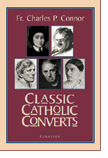

God disposed otherwise. Jewish tradition recorded that when Jerusalem was destroyed by the armies of Babylon, the prophet Jeremias took the ark of God away from the city, and buried it in some secret cleft of the rock; it was never seen again. Never again, except by St John, in his vision on the isle of Patmos; he saw the ark of God, but in heaven. And so it was with this new Ark of God, the virgin body that had been his resting-place. When and where she passed away from this earth, or in what manner, nobody can tell us for certain. But we know where she is. When Elias was carried up into heaven, the sons of the prophets at Jericho asked Eliseus if they might go out in search of him; "it may be", they said, "the spirit of the Lord has carried him off and left him on some hill-top or in some cleft of the valleys." He consented grudgingly, and when they returned from their fruitless errand, greeted them with the words; "Did I not tell you not to send?" [2] So it is with the body of the blessed Virgin: nowhere in Christendom will you hear the rumour of it. So many churches, all over the world, eagerly claiming to possess the relics of this or that saint; who shall tell us whether John the Baptist sleeps at Amiens, or at Rome? But never of our Lady; and if any of us still hoped to find that inestimable treasure, the Holy Father has called off the search, only the other day. We know where her body is; it is in heaven.
Of course, we knew it all along. For myself, I have never doubted the doctrine of the Assumption since I heard it preached forty-four years ago, in an Anglican church over at Plymouth. You see, we get it all wrong about body and soul, simply because our minds are dominated by matter. We think it the most natural thing in the world that soul and body should be separated after death; that the body should remain on earth and the soul go to heaven, once it is purged and assoiled. But it isn't a natural thing at all; soul and body were made for one another, and the temporary divorce between them is something out of the way, something extraordinary, occasioned by the Fall. In our blessed Lady, not born under the star of that defeat, human nature was perfectly integrated; body and soul belonged to one another, as one day, please God, yours and mine will.
Long ago, in those fields of Bethlehem, Ruth had gleaned in the footsteps of her beloved; and he, secretly, had given charge to the reapers to drop handfuls of corn on purpose, so that she might fill her bosom the sooner. So he, whose reapers are the angels, would leave for his blessed Mother a special portion of those graces that were to enrich mankind. The child-bearing which brought, to us others, redemption from the fault of our first parents should bring, to her, exemption; the empty tomb, which assures us that our bodies will rise at the judgment, was for her the earnest of an immediate resurrection; Christ the first-fruits, and who should glean them, but she? For that, heaven is the richer, earth the poorer. We can go to Lourdes, and offer adoration in the place where her feet stood; we cannot press with our lips some precious reliquary containing the hand that swaddled Christ. In a world so dominated by matter, in which matter itself seems to carry the seeds of its own destruction, there is no material object left that can link our destinies with hers.
And yet, is the loss all loss? When the dogma of the Assumption was defined a friend of mine, a very intelligent Mohammedan, congratulated me on the gesture which the Holy Father had made; a gesture (said he) against materialism. And I think he was right. When our Lord took his blessed Mother, soul and body, into heaven, he did honour to the poor clay of which our human bodies are fashioned. It was the first step towards reconciling all things in heaven and earth to his eternal Father, towards making all things new. "The whole of nature", St Paul tells us, "groans in a common travail all the while. And not only do we see that, but we ourselves do the same; we ourselves although we have already begun to reap our spiritual harvest, groan in our hearts, waiting for that adoption which is the ransoming of our bodies from their slavery." [3] That transformation of our material bodies to which we look forward one day has been accomplished—we know it now for certain-in her.
When the Son of God came to earth, he came to turn our hearts away from earth, Godwards. And as the traveller, shading his eyes while he contemplates some long vista of scenery, searches about for a human figure that will give him the scale of those distant surroundings, so we, with dazzled eyes looking Godwards, identify and welcome one purely human figure close to his throne. One ship has rounded the headland, one destiny is achieved, one human perfection exists. And as we watch it, we see God clearer, see God greater, through this masterpiece of his dealings with mankind.
(A sermon broadcast from Buckfast Abbey, Devon, on the Feast of Our Lady Assumption, 15 August 1954.)
ENDNOTES:
[1] Psalm 131:6.
[2] 4 Kings 2:16, 18.
[3] Romans 8:22-3.
Related IgnatiusInsight.com Links:
• IgnatiusInsight.com Author Page for Monsignor Ronald Knox
• The Modern Distaste for Religion | Ronald Knox
• The Mind of Knox | David Rooney
• The School of Ronald Knox | An Interview with David Rooney
• The Monsignor and the Don | An Interview with Fr. Milton Walsh
• Monsignor Ronald Knox: Convert, Priest, Apologist | An Interview with Fr. Milton Walsh
• Experience, Reason, and Authority in the Apologetics of Ronald Knox | Milton Walsh | From Ronald Knox As Apologist
• The Four Marks of the Church | Ronald A. Knox
• Review of The Belief of Catholics | Carl E. Olson
• Ronald Knox, Apologist | Carl E. Olson
• A Lesson Learned From Monsignor Ronald A. Knox | Carl E. Olson
• Converts and Saints | An Interview with Joseph Pearce
 Monsignor Ronald Knox (1888-1957) was the son of the Anglican Bishop of Manchester and it appeared that he, being both spiritually perceptive and intellectually gifted, would also have a successful life as an Anglican prelate. But while in school in the early 1900s Knox began a long struggle between his love for the Church of England and his growing attraction to the Catholic Church. He converted to Catholicism at the age of twenty-nine, became a priest, and wrote numerous books on spiritual and literary topics, including The Belief of Catholics, Captive Flames: On Selected Saints and Christian Heroes, The Hidden Stream: The Mysteries of the Christian Faith, Pastoral and Occasional Sermons, and many more. Visit Knox's IgnatiusInsight.com author page for more information about his life and work.
Monsignor Ronald Knox (1888-1957) was the son of the Anglican Bishop of Manchester and it appeared that he, being both spiritually perceptive and intellectually gifted, would also have a successful life as an Anglican prelate. But while in school in the early 1900s Knox began a long struggle between his love for the Church of England and his growing attraction to the Catholic Church. He converted to Catholicism at the age of twenty-nine, became a priest, and wrote numerous books on spiritual and literary topics, including The Belief of Catholics, Captive Flames: On Selected Saints and Christian Heroes, The Hidden Stream: The Mysteries of the Christian Faith, Pastoral and Occasional Sermons, and many more. Visit Knox's IgnatiusInsight.com author page for more information about his life and work.
Fairest Daughter of the Father: On the Solemnity of the Assumption

Fairest Daughter of the Father: On the Solemnity of the Assumption | Rev. Charles M. Mangan
The Solemnity of the Assumption, celebrated annually on August 15, presents a golden opportunity to reconsider the person of the Ever-Virgin Mary and her singular mission in the Church. We often contemplate the relationship between Mary and her Son; this reflection will focus on the relationship which Our Lady enjoys with the First Person of the Most Blessed Trinity.
Mary has been hailed as the "first-born" daughter of the Father. This reality is evident if one remembers that God--and in a specific way the Father--has created Mary, just as He has created us. She is "one of us" because she is fully human. We are children of the Almighty in a similar vein in which she is His daughter. As we rely on God for our very existence, so, too, does our Immaculate Mother.
What do the Father and His sinless daughter share? Venerable Pius IX (1846-1878), in his Apostolic Constitution Ineffabilis Deus (December 8, 1854) in which he once-and-for-all defined the truth of Our Lady's Immaculate Conception, wrote: "To her did the Father will to give His only-begotten Son--the Son Whom, equal to the Father and begotten by Him, the Father loves from His Heart--and to give this Son in such a way that He would be the one and the same common Son of God the Father and of the Blessed Virgin Mary."
The Father gave many overwhelming spiritual riches to Mary to strengthen her in her inspiring vocation as the Mother of His Son. Yet, He gave no greater gift than that of the Lord Jesus. Mary, in turn, imitated the Father in raising Jesus from before infancy to manhood. Jesus knew well the best of all gifts which His Mother faithfully imparted: the boundless love of His Beloved Father. Now, as the Son of Mary, Christ came to experience the love of His Mother which was patterned after that of His Father.
One may rightly assert that Jesus Christ is the link between the Father and Mary. We often claim that children receive much of their identity from their parents. Eye color, physical build and even disposition are often traced from the child back to its parents. Truly, the offspring rely on their father and mother for multiple and varied things. (And, of course, the Messiah willed to come forth from Mary and be dependent on her and Saint Joseph.) However, the Holy Family of Nazareth is a different case. Mary and her loving husband discovered their purpose in the Divine Child. In Jesus, they found their identity--unto everlasting life!
From her Immaculate Conception to her glorious Assumption body and soul into Paradise (and even now), Mary never lost her sense of utter dependence on the Father. Yes, she was chosen to be the Virgin Mother of Emmanuel. But, she always recalled that she needed God each moment of her life. When exclaiming the Lord's unparalleled goodness in the Magnificat (Saint Luke 1:46-55), this humble maiden declared: "The Mighty One has done great things for me, and holy is His Name" (Verse 49). She did not contend: "Holy is my name." Mary was entirely convinced that God alone is the source of all we are and all that we have.


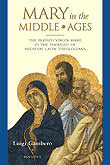







Father Jean Galot, a French theologian and member of the Society of Jesus and professor emeritus of Christology at the Pontifical Gregorian University in Rome, recently explored in an article the intimate bond between the heavenly Father and Mary. We are able to locate this connection "in the attitude of the Baby Jesus." Father Galot argues: "In His Infancy, He (Jesus) developed a double fundamental love. He said 'Abba' to the celestial Father and 'Mamma' to the earthly Mother. Other babies unite in the affection for father and mother, who are both human; Jesus associated a divine Father and a human Mother in the same filial love."
These two cries, "Abba" and "Mamma," came from the very same Person--Jesus Christ. It is apparent that the Child recognized in His Mother the care, concern--yes, charity!--which springs from the very Heart of the Father.
If we grant that God never does anything without a sufficient and the most excellent of reasons, then we must conclude that His choice of Mary as the Mother of the Master has certain spiritual ramifications for those who are the brothers and sisters of Jesus.
1) Mary teaches us how to love the Omnipotent One as we ought. Again, Mary is fully human. She is of the same "stuff" as we. Hence, we implore her powerful intercession in learning how to love the Holy Trinity as she does, our weaknesses notwithstanding.
2) The Father has a plan for our lives that we are to yield to immediately if we wish to be content. Imagine what Mary would have missed had she refused the Lord's tender mercy? He summoned her to become Jesus' Mother; she readily accepted. What we forego when we say "no" to our Creator! What we gain when we submit to His unfathomable will!
3) Only in Jesus Christ will we discover our identity and be filled with authentic happiness. The Redeemer teaches us the truth about Himself, His Father, the Paraclete, His Mother, and ourselves. He waits to form us in His Sacred Word. He will never compel us to consent to his desires, but how He wants us to! Mary saw in Christ the splendor of truth. Although she suffered intensely, especially on Calvary, her pure soul was steeped in joy because she courageously adhered to the designs of the Lord, no matter how challenging. The Holy Spirit granted her an abiding tranquillity which is indescribable.
The same Father Who sent His Son to Mary through the power of the Consoler invites us, as He did Mary, to find in Jesus the answer to all our questions and the balm to all the illnesses of our souls. We can seek to imitate in some way, with the Holy Spirit's assistance, Mary's sublime love of the Father. Our wholehearted acceptance of His love and compassion means that we will flourish spiritually in our day as the Mother of Christ did--and continues, now assumed into Heaven--in hers.
This article originally appeared in a slightly different form in the July/August 1999 issue of Catholic Faith magazine.
Related IgnatiusInsight.com Articles and Excerpts:
• The Blessed Virgin in the History of Christianity | John A. Hardon, S.J.
• "Hail, Full of Grace": Mary, the Mother of Believers | Joseph Cardinal Ratzinger
• Mary in Feminist Theology: Mother of God or Domesticated Goddess? | Fr. Manfred Hauke
• Excerpts from The Rosary: Chain of Hope | Fr. Benedict Groeschel, C.F.R.
• The Past Her Prelude: Marian Imagery in the Old Testament | Sandra Miesel
• Immaculate Mary, Matchless in Grace | John Saward
• The Medieval Mary | The Introduction to Mary in the Middle Ages | by Luigi Gambero
• Misgivings About Mary | Dr. James Hitchcock
• Born of the Virgin Mary | Paul Claudel
• Assumed Into Mother's Arms | Carl E. Olson
• The Disciple Contemplates the Mother | Erasmo Leiva-Merikakis
Monsignor Charles M. Mangan is a priest of the Diocese of Sioux Falls (South Dakota). He was ordained to the Priesthood in 1989. He currently works in the Vatican Congregation for Institutes of Consecrated Life and Societies of Apostolic Life
Why the German Bishops are Wrong about Abstinence for “Remarried” Catholics
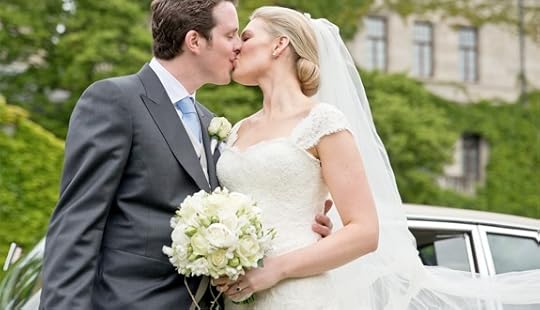
(CNS photo/Daniel Karmann, EPA)
Why the German Bishops are Wrong about Abstinence for “Remarried” Catholics | Dr. Stephan Kampowski | CWR
The second part of an essay examining the theological arguments put forward for the readmission of the divorced and civilly remarried to Communion.
This is the second part of an essay by Dr. Kampowski addressing theological arguments on divorce and remarriage, especially as these questions were raised during last year’s Synod of Bishops. In the coming weeks, Catholic World Report will be publishing Dr. Kampowski’s essay in five installments. The first can be read here.
One may wonder why Eberhard Schockenhoff claims that the step of entering into a second union is supposedly considered the “one unforgivable sin.” John Paul II’s apostolic exhortation Familiaris Consortio and Benedict XVI’s post-synodal apostolic exhortation Sacramentum Caritatis have made it clear that even those who are living in a second union, due to common commitments they cannot abandon, are not therefore confined to a tragic situation in which they have to sin. There is a morally feasible way out, namely, to make the commitment to live together as brother and sister, abstaining from acts that are proper to spouses. In a common publication my colleague Prof. Juan José Pérez-Soba and I wondered why in the pre-synodal debate this existing pastoral solution for accompanying the divorced and civilly remarried had been virtually excluded from public ecclesial discourse. It is hence a welcome step forward for the discussion that in its recent publication the German Bishops’ Conference explains the reasons why, to its mind, the solution offered by Familiaris Consortio n. 84 and Sacramentum Caritatis n. 29 is not helpful. In the whole document, the bishops essentially advance three considerations. On page 58 the first two arguments are presented, according to which the said proposal “isolates the sexual realm” and asks too much of the faithful:
To many of those concerned, the ecclesial advice of a conjugal life without sexual relations seems morally questionable, since it isolates the sexual realm and disintegrates life’s sexual dimension from the loving togetherness of man and woman. It tends to ask too much of those concerned and corresponds to the choice of a celibate form of life, to which, however, they are not called.
A little further down the bishops expand on why they think a more differentiated assessment of sexual acts in second unions may be called for. They begin by elaborating on the previously mentioned point about the isolation of the sexual realm:
The ecclesial provisions currently effective assess sexual relations in the new partnership as sinful. These provisions stand in a certain tension with the teaching of the Second Vatican Council on marriage. Marriage is not simply a sexual communion, but a personal relation of mutual love, to which belongs also the mutual sexual giving of oneself. This process view of marriage as a relational event contradicts the isolated consideration and assessment of sexual acts.
Then a further, new argument is advanced:
The Church can recognize the obligations that grow out of a new union. […] Such a union […] is a morally significant reality and cannot be arbitrarily destroyed without the partners incurring grave guilt. The exhortation to sexual continence in the new union can be morally questionable if it endangers the permanence of this union, from which not rarely children have sprung.
Thus there are essentially three reasons for why, to the mind of the majority of the German bishops, the proposal of Familiaris Consortio and Sacramentum Caritatis needs rethinking: calling the divorced and civilly remarried to a life of abstinence
isolates the sexual realm;
asks too much of people who do not have the call to celibacy;
endangers the new union that can be considered a morally significant reality.
In what follows we will discuss these arguments one by one.
New: "Test Everything: Hold Fast to What Is Good" by Cardinal George Pell
Now available from Ignatius Press:
Test Everything: Hold Fast to What Is Good
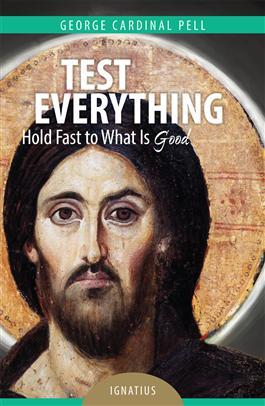
by Cardinal George Pell
This book can only be sold in the United States, US Territories and the Philippines.
“Test everything; hold fast to what is good; abstain from evil.’’ 1 Thessalonians 5:21
The renowned Cardinal George Pell, formerly Archbishop of Sydney and recently appointed by Pope Francis as Prefect of the Secretariat for the Economy at the Vatican, challenges readers with the admonition of Saint Paul to “test everything”. These powerful reflections consider some of the ultimate questions that confront us all: Why are we here? What is the purpose of life? What is the good we should do and the evil we should avoid?
Reaching out to youth, as well as to people of all ages, faiths, and experiences, Cardinal Pell uses an engaging style mixed with a keen Aussie wit. He writes as a seasoned story-teller, an expert historian, an insightful scholar, a patriot par excellence, and an outstanding Churchman.
His advice to all is credible, practical, and helpful: Search for genuine love. Do not follow the crowd. Remember to pray. He reminds Christians, “Every lover must be a fighter. . . . We know that evil will triumph if good people do nothing.” To those harboring doubts or tempted to disbelief he brings steadfast encouragement. “The Christian vision does not deceive,” he writes, “if it comes slowly, wait, for it will come without fail.”
Among the many interesting topics he discusses are the Trinity, the meaning of suffering, the relationship between faith and science, the role of Christians in public life, and the enduring wisdom of Humanae Vitae.
Cardinal Pell’s overall message points us to the Cross of Christ as the unique and final measure of what it means to be human, and thus holy. Cardinal Pell, modern man of faith, vision and action, inspires readers to go deeper and to “test everything”.
George Cardinal Pell, formerly Archbishop of Sydney, Australia, was appointed in 2014 by Pope Francis as Prefect of the Secretariat for the Economy at the Vatican. He received a Licentiate of Sacred Theology from Urbaniana University, and his Ph.D. in Philosophy from Oxford University. His previous books include Issues of Faith and Morals and an authorized biography by Tess Livingston, George Pell: Defender of the Faith Down Under.
You are Who you eat: "Let Christ be eaten..."
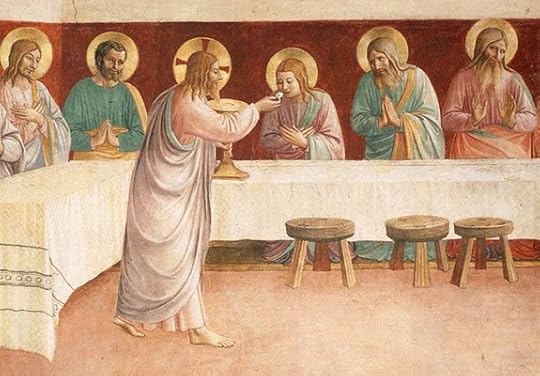
Detail from "Institution of the Eucharist" (1441) by Fra Angelico (www.wikiart.org)
You are Who you eat: "Let Christ be eaten..."
A Scriptural Reflection on the Readings for August 16, 2015, the Twentieth Sunday in Ordinary Time | Carl E. Olson
Readings:
• Prv 9:1-6
• Ps 34:2-3, 4-5, 6-7
• Eph 5:15-20
• Jn 6:51-58
“You are,” my mother—like most other mothers—used to tell me, “what you eat,”
“You are Who you eat,” says my Mother, the Church, as she has for two thousand years.
The Eucharist, wrote Ignatius of Antioch on his way to martyrdom, “is the medicine of immortality and the antidote against death …” The person “who receives the flesh of our Savior Christ and drinks his precious blood,” wrote Cyril of Alexandria, “shall be one with him.” Augustine put it boldly and simply: “Let Christ be eaten; when eaten he lives because when slain he rose again.”
“Let Christ be eaten”—that is the essence of today’s Gospel reading. It contains the fourth and final “Amen, Amen” statement from Jesus in his Bread of Life discourse. With each statement (Jn. 6:26, 32, 47), Jesus took his listeners deeper in the mystery of his person, mission, and gift of salvation—a mystery rooted in the Incarnation, pointing to his death and resurrection, and given to the Church in the Eucharist.
As Jesus revealed more, he met more resistance. At first his listeners asked questions (v. 30), then made demands (v. 34), then murmured openly (v. 41), and then began to quarrel over his words. Jesus’ claim that the bread of life he offered was somehow closely linked with his actual flesh was deeply offensive. It smacked of cannibalism, which was an offense providing evidence God had cursed his covenantal people (cf. Lev. 26:27-29). So if Jesus, in saying that “the bread that I will give is my flesh”, was using metaphorical or poetic language, surely he would have cleared up any misconceptions created by his startling language.
Jesus did clear up misconceptions, but not as many of his listeners probably hoped or expected. He clarified his remarks by emphasizing that, yes, he was speaking of his actual flesh and of real eating: “Amen, amen, I say to you, unless you eat the flesh of the Son of Man and drink his blood, you do have life within you.”
These words, more than any other in Scripture, stopped me cold in my tracks many years ago. As a Fundamentalist and, later, as an Evangelical Protestant, I had never heard a sermon or attended a Bible study that grappled with these words. The various books and commentaries I studied did not address satisfactorily the meaning and purpose of Jesus’ declaration, “For my flesh is true food, and my blood is true drink.” I asked the same question as those listening to Jesus in person: Whatever did he mean?
Part of the answer is found in how Jesus described himself as the “living bread that came down from heaven.” G. K. Chesterton, in The Thing: Why I Am a Catholic, expressed it well, “Heaven has descended into the world of matter; the supreme spiritual power is now operating by the machinery of matter, dealing miraculously with the bodies and souls of men.” Put simply, the Eucharist is a continuation of the Incarnation. By becoming man, the Son of God took on flesh—not in appearance only and not for just a few years, but in actuality and for all of eternity.
The Creator, having taken on flesh, now brings about a new creation by inviting man to receive his flesh and blood in the Most Holy Eucharist. Having become man, the Son gives himself to us so that we, made sons of God through baptism, might continue growing in truth and grace and divine life, feeding on his life-giving flesh and blood. The Eucharist does not just sustain us, but transforms us; it does not just fill us, but completes us.
John Paul II, in his encyclical Ecclesia de Eucharistia, wrote, “The Church draws her life from the Eucharist”, and explained that those who receive the Eucharist become “the Body of Christ—not many bodies but one body.”
How do we remain in Christ and become more Christ-like? By eating his flesh and blood. You are Who you eat.
(This "Opening the Word" column originally appeared in the August 16, 2009, issue of Our Sunday Visitor newspaper.)
August 14, 2015
The Consistent—and Not So Seamless—Ethic of Life
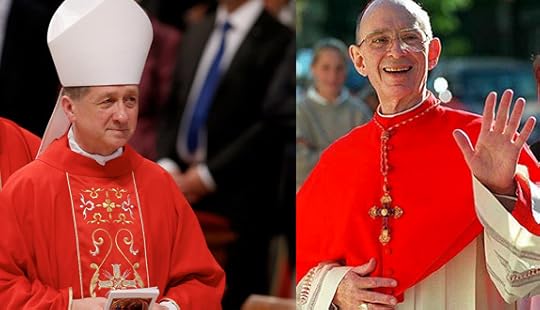
Abp. Blase Joseph Cupich (left) was installed as head of the Archdiocese of Chicago on Nov. 18, 2014 (CNS); Joseph Cardinal Bernardin (right) was Archbishop of Chicago from 1982 until his death in 1996 (Wikipedia).
The Consistent—and Not So Seamless—Ethic of Life | Dr. Samuel Gregg | CWR
Archbishop Blaise Cupich's appeal to Cardinal Bernardin's "seamless garment" approach to ethics is flawed on several counts, including a failure to acknowledge the primacy of the laity in pursuing good public policy
In an August 3rd Chicago Tribune article, Archbishop Blaise Cupich of Chicago suggested that the widespread outrage ignited by the revelations that Planned Parenthood was selling body-parts extracted from aborted children represented an opportunity for Americans
to reaffirm our commitment as a nation to a consistent ethic of life. While commerce in the remains of defenseless children is particularly repulsive, we should be no less appalled by the indifference toward the thousands of people who die daily for lack of decent medical care; who are denied rights by a broken immigration system and by racism; who suffer in hunger, joblessness and want; who pay the price of violence in gun-saturated neighborhoods; or who are executed by the state in the name of justice.
Archbishop Cupich was quite right to underscore the classical Christian insight that good can be drawn out from evil, just as the Fall leads to Redemption. Much attention, however, was directed to the Archbishop’s use of the expression “a consistent ethic of life”: a phrase which has been used by members of the American Catholic episcopate as far back as a 1971 speech delivered by then-Archbishop Humberto Medeiros of Boston.
The term itself was brought to prominence by another Chicago archbishop, Cardinal Joseph Bernardin. In approximately 15 addresses delivered between 1983 and 1986, Bernardin called for the development of such an ethic and outlined how it might inform the way in which Catholics—lay and clerical—approached public policy issues.
Right from the beginning, forceful criticisms were made of the consistent ethic position (often described as the “seamless garment”). One was that it would inadvertently help provide “cover” for Catholic politicians who supported legalized abortion. Cardinal Bernardin himself lamented in a 1988 National Catholic Register interview that
I know that some people on the left, if I may use that term, have used the consistent ethic to give the impression that the abortion issue is not all that important any more, that you should be against abortion in a general way but that there are more important issues, so don’t hold anyone’s feet to the fire just on abortion. That is a misuse of the consistent ethic, and I deplore it.
Ten years later, the United States Catholic Conference’s document Living the Gospel of Life also criticized those who had used the consistent ethic to relativize the killing of unborn human beings by making it just one of a laundry list of concerns.
In a way, however, the political fallout from the consistent ethic distracted attention from significant ambiguities that characterized important aspects of the seamless garment’s theological and philosophical apparatus. In light of what seem to be efforts to revive this approach as a way for Catholics and, more particularly, Catholic bishops to engage in public policy debates, it’s worth revisiting these problems.
An Anthropology of Gaudium et Spes (Part 2)

Elohim (God) Creating Adam, William Blake (c. 1805).
An Anthropology of Gaudium et Spes, Part 2 | Francis Etheredge | HPR
If God freely made us in His image and likeness, then his Word is indispensible to our self-understanding; indeed, “man, male and female” (cf. Gn 1 27), makes “visible” the unfathomable mystery of the Blessed Trinity.
In Part II of this work (Part I is here), there is a continuation of the dialogue with Gaudium et Spes and, subsequently, an increasingly necessary turn to the first chapters of Genesis. It is almost as if, then, the words of Christ are prophetic for our times: “Have you not read that he who made them from the beginning made them male and female” (Mt 19: 8); indeed, the words of Christ are prophetic for understanding who we are in the light of who God is.
________________
On the one hand, the structure of human nature and the characteristics of human experience are ordered to the humanity of Christ, as his humanity is, as it were, made in the image of God as the new Adam (cf. Gaudium et Spes, 22). But on the other hand, being divine, entails that the humanity of Christ is intrinsically ordered to the mystery of Christ as a divine person. Thus, the Fathers are affirming the intelligibility of the existence of a Creator-God in whom the whole truth concerning man finds its coherent origin and end; indeed, as the document says later: ‘When God is forgotten, however, the creature itself grows unintelligible’ (Gaudium et Spes, 36). In a word, then, if our existence, in the full range of our lived experience, is coherent and intelligible in the light of reason and of Revelation,1 then creation as a communication of the Creator becomes clearer and, if clearer, more obviously in the nature of a created gift communicating the uncreated Gift of God. Thus, this “consciousness of creation”2 is a key to grasping the perception of created reality of a gift of love: “Creation is God’s first advance towards man, the first outflow of his love with a view to giving himself to man and establish{ing} communion with him.”3
Finally, although this essay will not directly pursue the question further, it is noticeable that the Fathers of the Council, having established the “being” of man, male and female, between the two poles of natural and supernatural truth, then go on to specify Chapter Three in the following way: “Man’s Activity in the Universe.” In other words, the structuring principle in the order of these Chapters, particularly 1-3, is philosophical: being manifestsactivity.4
But then, having addressed the characteristic activities of man, male and female, the Fathers then address the interaction of the Church and the World in Chapter 4, culminating with a return to Christ at the end of it: a return to Christ which also announces the Second Coming of Christ and, thus, reinserts us in the eschatological anthropology which is, as it were, constitutive of the very coming of Christ (Gaudium et Spes, 45). It is only after these steps that progressively structure our participation in the progress of man in the history of salvation that we come to the particular question of marriage and, as it were, the restoration of the language of the covenant: the original act of God which differentiates salvation history (Part II of Gaudium et Spes, 48). Thus, there is a brief account of the historical situation in which men and women live (Gaudium et Spes, 47); but then, also, there is a recovery or, better, a realization of the interrelationship between “covenant” and “sacrament.” In other words, there is a renewal of the language of marriage in the light ofthe history of God’s salvation of the human race.
Taking account, then, of an observation of St. John Paul II, there also emerges a clear sense that Christ and the Blessed Trinity are the answer to an existential account and analysis of man’s situation in the world, both as an individual and as a social being.5 An account, however, that is not just doctrinal but is, as it were, inviting us to find the life of Christ “lived” in the liturgical life of the Church, the living help that modern man needs.
August 13, 2015
Biography of Junipero Serra now available in paperback from Ignatius Press
Biography of Junipero Serra, soon to be canonized by Pope Francis, now available in paperback from Ignatius Press
San Francisco, August 13, 2015 – Ignatius Press announces the release of a paperback edition of the book The Man Who Founded California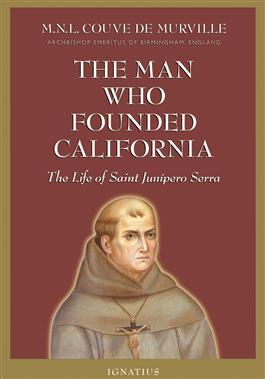 , a popular but thorough biography of Junipero Serra (1713-1784), the tireless Franciscan missionary who came to California in the eighteenth century to evangelize the Native Americans. Pope Francis will canonize Serra a saint on September 23rd during his historic visit to the USA and this important book provides a detailed account of the amazing faith and works of this beloved missionary.
, a popular but thorough biography of Junipero Serra (1713-1784), the tireless Franciscan missionary who came to California in the eighteenth century to evangelize the Native Americans. Pope Francis will canonize Serra a saint on September 23rd during his historic visit to the USA and this important book provides a detailed account of the amazing faith and works of this beloved missionary.
Well known for the 21 historic missions he helped establish all along the coast from San Diego to San Francisco, Serra is recognized by the United States government as the “Founder of California”. As one of the pioneers who created the United States of America, his larger than life-size statue stands in the hall of the U.S. Capitol.
The author of The Man Who Founded California, Archbishop Couve de Murville, presents an historical and spiritual biography of Serra from his childhood and students days in Majorca, Spain, to his time in Mexico, and to his great missionary work in California. Regarded as a great teacher by his order, Serra was initially a professor of theology at the Lullian University in Palma, Spain. After teaching for five years, he answered the call to be a missionary to the New World, and embarked on a ship to Mexico in 1749. For the rest of his life he worked tirelessly as a preacher and a missionary in Mexico and California, his motto being “Always forward, never back.”
Father Serra’s presence and work are still very much alive though the beautiful missions that are visited by millions of people every year. This paperback edition includes numerous illustrations, most in color, of the life and work of Serra, especially of the missions that dot the landscape of California, many gloriously restored to their original beauty.
St. John Paul II, who beatified Junipero Serra in 1988, explains, “At crucial moments in human affairs, God raises up men and women whom he thrusts into the roles of decisive importance for the future development of both society and the Church. We rejoice all the more when their achievement is coupled with a holiness of life that can truly be called heroic. So it is with Junipero Serra, who in the providence of God was destined to be the Apostle of California.”
“Junipero Serra is a great example for Catholics. He dedicated his life to the mission of evangelization, to bringing the good news of the Gospel to America. He understood that the purpose of the Church is to help us all grow as human persons and to respond to God’s call: to love God and love others,” says the Most Reverend Jose Gomez, Archbishop of Los Angeles, California.
About the Author: M.N.L. Couve de Murville was the Chaplain of Cambridge University for five years before becoming the Archbishop of Birmingham, England, from 1982-1999.
Anthony Ryan, the Director of Sales and Marketing for Ignatius Press, is available for interviews about this book. To request a review copy or an interview with Anthony Ryan, please contact:
Rose Trabbic, Publicist, Ignatius Press at (239) 867-4180 or rose@ignatius.com
Product Facts:
Title: THE MAN WHO FOUNDED CALIFORNIA
The Life of Saint Junipero Serra
Author: M.N.L. Couve de Murville
Release Date: August 2015
Length: 142 pages, illustrated
Price: $17.95
ISBN: 978-1-62164-057-8 • Softcover
Order: 1-800-651-1531 • www.ignatius.com
Great Catholic Music Debate: “Post-Vatican Folk” vs. “Reformist Retro”

Great Catholic Music Debate: “Post-Vatican Folk” vs. “Reformist Retro” | Bill Kassel | Homiletic & Pastoral Review
A funeral I attended recently illustrates a musical dilemma that fuels the ire of Catholics on Facebook whenever the subject of liturgy comes up.
To set a tone of solemnity, two women chanted a Latin prelude as mourners entered. The casket was wheeled in with family members processing to the opening hymn, “Here I Am, Lord” (by ex-St. Louis Jesuits member, Dan Schutte), a classic of the post-Vatican “folk” musical repertoire.
The offertory song was Michael Joncas’s “On Eagles’ Wings,” another “folk” favorite, and one that has become a staple at funerals in churches of pretty much all denominations.
Two hymns of more traditional pedigree, “Adoro te Devote” and “The Strife Is O’er” were sung during Communion. There was also an instrumental interlude: Schubert’s “Ave Maria,” played on what sounded like a hammered dulcimer.
The final prayers of commendation were followed by another Latin chant. And the recessional hymn was “Be Not Afraid” (by Schutte’s former colleague, Bob Dufford).
The musicians did a fine job, though it can’t be said that these disparate elements fitted together all that well. But the music had been chosen by the family, and the selections demonstrated a basic fact of human nature: At times of emotional intensity and spiritual significance people like to hear familiar songs that comfort, encourage, and, in various ways, uplift them.
This emotional dimension is often not top-of-mind among Catholics who think about liturgy. That’s especially true for those of traditionalist sentiment (amply represented among my Facebook friends).
These people are drawn toward what they would call a more “sanctified” worship experience in which hymn preference skews to the classical and time-honored, if indeed hymns are included at all. Many urge abandoning hymnody altogether in favor of singing the Mass propers.
It goes without saying that the “folk” repertoire is anathema, seen as a flawed product of the worship form referred to contemptuously as “guitar Mass.” Countless Facebook postings (and articles linked to them) are replete with tales of wandering into some parish where the dreaded guitar group still prevails, and having to endure the pain and embarrassment of liturgical desecration.
Facebook traditionalists also comment on the poor quality of this music—poor in both composition and performance. Their complaints are often justified. Who hasn’t sat through at least one teeth-grinding rendition of “I Received the Living God” offered by a slipshod, three-chord guitar ensemble?
What the tradition-minded have difficulty recognizing (and find dispiriting when they do) is that many Catholics like the “folk” stuff.
August 12, 2015
New: "Living the Truth in Love: Pastoral Approaches to Same-Sex Attraction:
Now available from Ignatius Press:
Living the Truth in Love: Pastoral Approaches to Same-Sex Attraction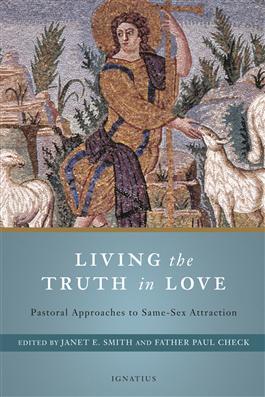
by Janet E. Smith and Fr. Paul Check
Available end of August 2015.
Living the Truth in Love grew out of the desire to provide answers to the questions posed for the Synod on Marriage called by Pope Francis:
How can the Christian community give pastoral attention to families with persons with same-sex attraction?
While avoiding any unjust discrimination, how can the Church give such persons pastoral care in light of the Gospel?
How can God's will be proposed to them in their situation?
People who want to be instruments of Christ's love to those who experience same-sex attraction (SSA) seek guidance on how best to do so. They need to listen to the stories of those who experience SSA and the stories of those who have accompanied them on their journeys. They also need to ground their responses in a genuine Christian understanding of the human person and of human sexuality.
This volume includes essays that lay out the Christian view of the human person and of human sexuality, essays that challenge the bifurcation of sexualities into "heterosexual" and "homosexual". Topics include an explanation of the meaning of the word "disorder", a discussion of the therapeutic power of friendship, and an application of Saint John Paul II’s personalism to the question of same-sex attraction. Psychologists and counselors explain various ways of affirming those who experience SSA and of leading them to experience the power of Christ’s healing love. Several of those who experience SSA tell their touching and inspiring stories.
Janet E. Smith, Ph.D., holds the Father Michael McGivney Chair of Life Ethics at Sacred Heart Major Seminary in Detroit. Father Paul Check is the Executive Director of Courage International.
"This is a deeply serious response to Pope Francis' call to the Church to engage the crisis of the family in all its dimensions and a critically important contribution to one of the great pastoral challenges facing the New Evangelization."
— George Weigel, Distinguished Senior Fellow, Ethics and Public Policy Center
"This book involves a large number of talented authors who engage both head and heart in the best tradition of Catholic pastoral theology."
— Helen Alvaré, Professor of Law, George Mason University
"I salute the distinguished authors of this important volume. I salute them not only for their wisdom but also for their bravery. It is a bravery born of love."
— Robert P. George,McCormick Professor of Jurisprudence, Princeton University
"The Church has a positive message for people who live with same-sex attraction, which comes through clearly in these pages and from many different perspectives. For many people this book can be life-changing. For those who serve in the Church’s ministry, it will be indispensable."
— Donald Cardinal Wuerl, Archbishop of Washington, D.C.
"Living the Truth in Love is a courageous, sincere, and timely book that seeks to help those with same-sex attraction and all of us who love them with the powerful medicine of the Gospel, the psychological sciences, and the inspiring witness of those with SSA who are living chaste, loving, joy-filled, Christian lives."
— Sean Cardinal O’Malley, Archbishop of Boston
Carl E. Olson's Blog
- Carl E. Olson's profile
- 20 followers



